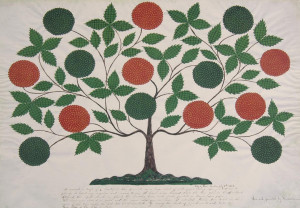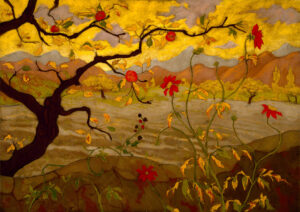
In May of 1774, a woman called Ann Lee, along with a small band of eight followers, set sail from Liverpool upon an old ship called the Mariah. Barely seaworthy, the Mariah sailed west, across the Atlantic, bound for the British colony of New York. These folks called themselves the United Society of Believers in Christ’s Second Appearing, and as for Ann Lee: they called her Mother Ann. Mother Ann had had a vision that beckoned her to gather her small flock and to leave behind the persecution they’d been facing in England and to begin anew on the other side of the ocean.
The captain of the ship didn’t necessarily enjoy the presence of this oddball religious sect, but paying passengers are paying passengers. Still, two and a half months’ passage is a long time, especially when all one sees is water and folks dancing and whirling in ecstatic prayer. There were some tense moments on the voyage, especially during one treacherous evening when the leaky old ship nearly went down in a storm. As the Mariah took on water, Mother Ann calmly approached the captain and told him, “Captain, be of good cheer; there shall not a hair of our heads perish; we shall all arrive safe in America. I just saw two bright angels of God standing by the mast, through whom I received this promise.”
Soon after, as the story goes, a great wave struck the ship and the force of it slammed a loose plank into place, sealing the ship and stopping the leak. After witnessing this, the captain gave his strange passengers full liberty to worship as they wished. When they finally reached New York Harbor after the long, treacherous passage, the captain declared that “but for these people we never would have reached America.”
As with any group that is a bit different, they were met with suspicion and distrust, and because of their whirling and dancing in worship, some people here in the States began calling them Shaking Quakers. That was meant to be derogatory, but the United Society of Believers, in one of the earliest acts of empowerment, took the name for themselves, and began calling themselves Shakers, too. The movement gained a foothold. The Shakers ultimately founded 21 Communities in the 18th and 19th centuries, stretching from Maine to Kentucky, with even a short-lived Community here in Florida, at Kissimmee.
That Sixth of August, 1774, when Mother Ann first stepped foot on American soil, is marked to this day by our friends at Chosen Land, the Shaker Community at Sabbathday Lake, Maine, as The Glorious Sixth or as Arrival Day: the Arrival of the Shakers in America. Chosen Land is the only remaining active Shaker Community anywhere. And this year, being the 250th anniversary of Mother Ann’s arrival in America, is extremely special to them. For months now, thanks to our love for Chosen Land and the people who call that place home, I have known exactly what the Convivio Book of Days Calendar for August would look like. August begins with Lammas, and it brings the end of the Dog Days of Summer, and it brings Obon, the enchanting Japanese celebration honoring the dead, and it brings Ferragosto to Italy and the Bartlemas Wayzgoose, too… but the Shakers are the stars this month for me, and Arrival Day is what I want to talk about in this chapter of the Convivio Book of Days.
You can read about the history of the Shakers elsewhere, and you can read about their wonderful contributions to classic American design (you can even buy a set of commemorative stamps right now from the US Postal Service, celebrating 250 years of Shaker design). Me, what I love best is a good story, and for Seth and me, our Shaker story begins with the fact that Seth grew up in the town in Maine adjacent to the town where Chosen Land is. At Gray-New Gloucester High School, Seth had classes with names like “Shaker Studies,” and he spent summers working in the Shaker gardens and giving tours at the museum there at Shaker Village. And it was Seth who suggested to Brother Arnold Hadd that opening his printshop (and heart) to a quirky young guy who was interested in letterpress printing and bookbinding and history might be a good idea. Brother Arnold decided Seth was right. And so I spent the summer of 1996 at Chosen Land, researching, designing, printing, and binding, with Brother Arnold, a book about Deacon James Holmes, the very first printer there at Chosen Land. Deacon James was probably a bit quirky, too. He’d come to the Community as a young man himself in 1783. He remained there all his life. When he was in his 80s, he came into possession of some cases of metal types for printing and decided (naturally) the only thing to do was to build himself a printing press, which he did. Deacon James went on to print books and broadsides and seed packets for the Shakers’ new garden seed industry. My kind of guy.
The Shakers that summer––and there were eight of them at the time, just like the band of eight that followed Mother Ann to the New World––made Seth and me so welcome into their Community. The greatest privilege I had that first summer, and one of the greatest privileges of my life, was to be welcomed into their August 6 celebration of Arrival Day. I’ve told this story many times before, but it is so much a part of me and my Shaker experience, that I beg of you to let me tell it again. But those are the best stories, no? The ones we tell again and again. So, here we go:
That Sixth of August celebration in 1996 began no differently, I imagine, than they always did and always do: With a wonderful meal, in community with all gathered. Now, nearly 30 years later, there are but two Shakers: Brother Arnold and Sister June, Elder and Eldress by default, I suppose, but certainly there will be many friends of the Community at table with them for the meal. The meal will be at the end of the day, and then, as night begins to fall, the small band of believers will move from the Dining Room to the Chapel. Not the 1794 Meetinghouse, for Sister June can no longer make the passage across the road to that enchanted building, but to the Chapel that is in the Dwelling House and that was, originally, reserved for Shaker Meeting during the winter, when it was too cold or snowy to use the old Meeting House.
But on that August 6th night in 1996, it was to the 1794 Meeting House that our small band of believers went. The building is beautiful in its simplicity. There are no column supports to interrupt the openness of the main room, which gave the early Shakers plenty of room for their dancing. And while the Shakers today do not dance, still the building inspires. Whenever I am there, I look at the wide plank floor. I think of all the Shakers who whirled and danced on those floorboards. I look at the beams painted with blueberry milk paint, the original paint from 1794, still blue, still the hue of sky at dusk.
As at any Shaker Meeting, there are readings and set Shaker songs. One song that is always sung on this night begins At Manchester in England, this blessed fire began / And like a flame in stubble, from house to house it ran. The song, called “Mother,” was written in 16 verses by Elder Richard McNemer and published in 1813 in the first Shaker songbook, Millennial Praises. Aside from the readings and set songs at the beginning, there are testimonies from anyone who is moved to stand and speak, followed always by Shaker spirituals inspired by those testimonies. And through it all, at least for that August 6th evening in 1996, despite the lanterns that were illuminated at the start of Meeting, night slowly descended upon the Meetinghouse and the Community gathered, wending its way, weaving its magic.
I don’t think I will ever forget what happened as the room filled with darkness and lamplight. The women sat on one side of the room and the men on the other, as is the Shaker custom, and in the faces of the sisters and other women across from me, I could discern the faces of Shaker sisters throughout time. I knew I was looking at Sister Frances and Sister Marie and Sister June and Sister Ruth and all the other women gathered there with them, but their visages seemed to shift in the twilight, so I could see Sister Mildred, too, and Sister Aurelia and Sister Elsie McCool and countless others whose names I’d never know. We may have entered the Meetinghouse in 1996, but it didn’t seem to remain 1996. Sacred spirit filled that sacred space.
If you’ve stayed with me all this time, through all these paragraphs, perhaps you, too, love a good story. My life has been filled with so many moments like this. I’m a very lucky guy, I know it.
And if you’ve stayed with me through all these paragraphs, you deserve a reward. And so here is your Convivio Book of Days Calendar for August. It is, as are all Convivio Book of Days Calendars, a printable PDF, and a fine companion to this blog. Aside from Arrival Day coming on the Sixth, today brings Lammas (Lughnasadh in the Celtic calendar). It is a day not much celebrated here in the States, but this is our loss, for the value of Lammas is in its gentle reminder that summer is ripening, maturing, shifting to hues of gold, as we make our way toward autumn. It is, in fact, a cross-quarter day: we find ourselves, with Lammas, in the Northern Hemisphere, at the halfway point between the Midsummer solstice and the Autumnal equinox. This, to me, anyway, is a day worth noting. It is known as First Harvest, and it is traditional to bake a loaf of bread on Lammas, and to enjoy perhaps a wee dram of whisky (which is also made from grain).
*
WAYZGOOSE CELEBRATION
We’re planning a small Bartlemas Wayzgoose celebration at our new shop the weekend of Saturday August 24 & Sunday August 25. What we know so far is it begins with a book arts workshop focused on non-adhesive bindings that I’ll be teaching, called Pure Bookbinding. That’s on Saturday August 24 from 10 AM to 1 PM, and currently there are only 3 seats left. We’ll continue the celebration probably from about 3:00 on Saturday, into the evening, then again on Sunday with whatever interesting and fun ideas Seth and I can come up with. Details still to come…. watch the blog and our social media channels through August so you don’t miss it.
Everything we offer at Convivio Bookworks has a story, and now you know (in case you didn’t before) why we sell culinary herbs and herbal teas from the Sabbathday Lake Shaker Community. The Community’s herb industry began in 1799. Find the Shakers’ rose water, potpourri, herbal teas, and culinary herbs at our online shop or in store, when you come see us in our new shop at 1110 North G Street in Lake Worth Beach.
Bonus Materials for you: A Facebook Live broadcast from August 5, 2020, called Book Arts 101: Simple Gifts, featuring Seth and me talking about our time with the Shakers. Plus a full library of early Book Arts 101 talks, before they moved from Facebook Live to Vimeo, is available by clicking here. (Should you need a rabbit hole to fall into.)
A YELP STORY ABOUT CONVIVIO BOOKWORKS
A few months ago, I answered some questions that the folks at Yelp Broward/Palm Beach sent, and just tonight they published a “Meet the Owners” feature about us. Click here to check it out on Instagram (or visit their page at @yelpbrowardpalmbeach).
*
Our cover star for today’s chapter and for this month’s Convivio Book of Days Calendar is a Shaker gift drawing called “Tree of Life.” It was painted on paper by Sister Hannah Cohoon in 1854 at the Hancock Shaker Community in Massachusetts. Gift drawings were indeed seen by the Shakers as gifts: visions handed to them from the spiritual realm.


